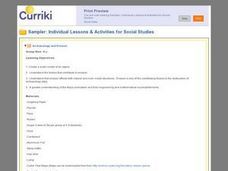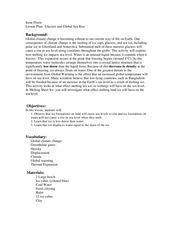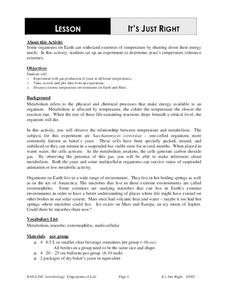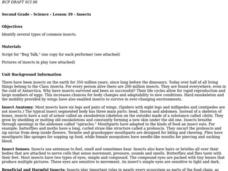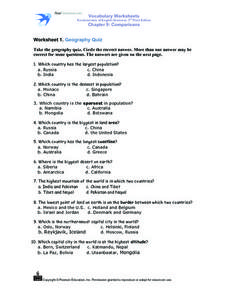Curated OER
Fossils Footprints Across Time
Students examine fossils to understand how they are formed and how they give information about geological history. In this fossil lesson, students research and write about fossils and make models of different fossil types.The PDF...
Curated OER
Going...going...gone? Tropical Rainforests-How They Work, What They Do for Us, What's Being Done to Them...
Sixth graders explore the Tropical Rainforest and come to understand what it is and how it affects the ecosystem. In this rainforests activity, 6th graders write about the Tropical Rainforest, imagine they are in the Tropical...
Curated OER
Archaeology and Erosion
Sixth graders study how erosion affects archaeology sites. In this investigative lesson, 6th graders construct a model of a pyramid using sugar cubes. They will investigate in groups how water, wind, and sunlight affects their model...
Curated OER
The Awful 8: The Play
Students perform a play based on pollution. In this pollution science lesson, students perform a play about different pollutants and how it effects our daily lives.
Curated OER
We've got the whole world in our hands
Students explore spatial sense in regards to maps about the globe. In this maps lesson plan, students label oceans, locate the continents and poles, follow directions, and explain the symbols on a map.
Curated OER
Feature Column: Virtual Field Trips
Students discover ways to stay healthy by utilizing Internet education software. In this computer technology lesson, students investigate Internet programs that simulate a field trip by showing images and video. Students...
Curated OER
Checking Facts with Snopes, Factcheck & Politifact
High schoolers examine the art of fact-checking. In this current events lesson plan, students read the provided article "Snopes: The Internet Cesspool," "FactCheck: Proceed with Caution," and "Politifact: Separating Fact from Fiction."...
Curated OER
Nouns
In this nouns worksheet, students read 45 sentences and determine which nouns name a person, place and/or thing, Students read an additional 15 sentences, underline each noun in each one and then decide whether each one is a person,...
Curated OER
Glaciers and Global Sea Rise
Learners explain how melting glaciers affect global warming. In this earth science instructional activity, students investigate the change in ice density as it melts. They discuss the human and environmental impact of rising sea levels.
Curated OER
It's Just Right
Young scholars conduct an experiment to determine the temperature tolerance of yeasts. For this biology lesson, students collect data and compare them by plotting graphs. They explain how extreme temperatures affect organisms.
Curated OER
Searching for Meteorites
Students examine meteorites and attempt to recover meteorite fragments. In this space lesson students complete a demonstration on the impact of a meteorite using water balloons and make experimental predictions.
Curated OER
The Barn Owl Pellet
Seventh graders examine the factors that affect the number and types of organisms that an ecosystem can support. In this ecosystem instructional activity students study the barn owl and where it is on the food chain, then dissect...
Curated OER
Insects
Second graders brainstorm and identify several types of common insects. They play bug bingo, building bugs and an insect tree, observing real insects in the classroom and examining some of the things insects make.
Curated OER
The Ancient World Explorer
Students investigate the ancient structures of Mesopotamia, Egypt, India, and China. In small groups, they conduct research, evaluate their findings within the group, create visual aides, and complete an Internet treasure hunt.
Curated OER
Adaptations of Fishes for Survival in Polar Environments
Learners compare the anatomy of temperature and polar fishes. They explore the adverse effects of cold on metabolism and physiology and discuss how polar fishes adapt to their environments. Comparisons are also made to the DNA sequences...
Curated OER
Migrate, Adapt, or Hibernate
In this migration and hibernation worksheet, students read a 2 page informational excerpt about animals who adapt to changing seasons by migrating or hibernating. They then use the information they learned to answer the 15 questions on...
Curated OER
Past Time: Vocabulary Practice
In this past time worksheet, students select the word or phrase from 3 choices that means the same as the word in bold in 12 sentences. All pertain to events in the past.
Curated OER
Adjectives
In this adjectives practice worksheet, students choose describing words with opposite meanings. Students complete twelve sentences.
Curated OER
Worksheet 1: Geography Quiz
Students take a geography quiz and circle the multiple choice answer that answers each question correctly. The quiz is quite-challenging, and an atlas may be required to help the students. An answer sheet is provided.
Curated OER
"ART ZOO 'Blacks in the Westward Movement', 'What Can You Do with a Portrait', and 'Of Beetles, Worms, and Leaves of Grass'"
Students study black history, examine portraits and portrait making and create their own portraits, and investigate their natural environment. This humanities lesson provides a text that can be used to teach lessons in black...
Curated OER
Temperature Conversions
In this temperature conversions worksheet, high schoolers are given the equations to convert from one unit of temperature to the other. They solve four problems using these equations.
Curated OER
Continent Word Search
In this continents word search worksheet, students locate the names of the 7 continents, listed in the word bank, within the word search puzzle. Students fill in the blanks in 8 sentences with the appropriate continent names.
Curated OER
Paraphrasing
For this paraphrasing worksheet students are tasked to paraphrase five short passages. Students write their paraphrase and can then self check against sample answers.
Curated OER
Continental Drift Lab-Wegener's Evidence
For this continental drift worksheet, 7th graders answer 7 questions about Wegener's theory of continental drift. They use a diagram of the Earth's continents that show plate tectonics.




